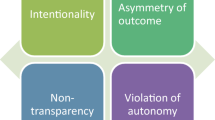Abstract
The last two decades in the field of artificial intelligence have clearly shown that true intelligence always requires the interaction of an agent with a real physical and social environment. The concept of embodiment that has been introduced to designate the modern approach to designing intelligence has far-reaching implications. Rather than studying computation alone, we must consider the interplay between morphology, materials, brain (control), and the environment. A number of case studies are presented, and it is demonstrated how artificial evolution and morphogenesis can be used to systematically investigate this interplay. Taking these ideas into account requires entirely novel ways of thinking, and often leads to surprising results.
Similar content being viewed by others
Author information
Authors and Affiliations
Corresponding author
Additional information
This work was presented, in part, at the 9th International Symposium on Artificial Life and Robotics, Oita, Japan, January 28–30, 2004
About this article
Cite this article
Pfeifer, R., Gómez, G. Interacting with the real world: design principles for intelligent systems. Artif Life Robotics 9, 1–6 (2005). https://doi.org/10.1007/s10015-004-0343-3
Received:
Accepted:
Issue Date:
DOI: https://doi.org/10.1007/s10015-004-0343-3




